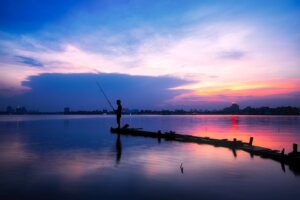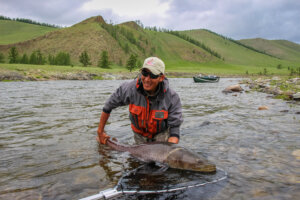Fly Fishing Honduras: Lodges and What to Expect
Nestled 40 miles off the coast of Honduras is a place known as the Bay Islands. With lush green mountains, natural freshwater springs, and barrier reefs just off the white sand beaches, fly fishing Honduras is truly a like no other fishing experience on earth. Two of the main bay islands: Roatán island and Guanaja island are the crown jewels of this area and home to a truly remarkable and unblemished fishery. Both Honduran islands offer world-class fishing lodges and accommodations to boot. The Guanaja Lodge is located on Guanaja island and the Mango Creek Lodge is located on Roatán island.
The Guanaja Lodge, located on Guanaja island is nestled in the small fishing village of Mangrove Bight, which has integrated perfectly with the friendly natives inhabiting the island. The flats boats are all custom-made by a local craftsman and the guides have every flat, ledge, and tide engrained into their memories. Roatán island lies just to the west of Guanaja and also offers world-class fly-fishing.
The Mango Creek Lodge is unspoiled by overdevelopment and tourism that would otherwise detract from its natural and unspoiled beauty. Stilted cabanas just above the waters of Roatán’s Port Royal provide an immersive relaxation after a long day of fly fishing.
Tales of these islands holding schools of giant Bonefish, Tarpon, and Permit hundreds strong as they move and down the flats just offshore are extremely common. Surprisingly, and thankfully, these tales are not found wanting. The flats are similar to the Florida Keys decades ago, with hard sand, turtle grass, and coral dotting the flats. This bottom variety also attracts other species from the reef, and catching triggerfish, snapper, and grouper on the fly isn’t unheard of. Fly fishing Honduras is like taking a step back through time and fishing the unpressured flats of the Bahamas and Florida keys.
Tackle
Although the guided trips will have all the tackle provided to the angler, I have always felt more comfortable bringing a rod and reel of my own on fishing trips. Due to the numerous numbers of trophy-class fish, you will see when fly fishing Honduras, I recommend at least a 9wt or a 10wt rod with a reel to match. You will want something that can handle anything from a 5lb bonefish to a 30lb tarpon that isn’t going to wear you out from casting all day long.
Also, a considerable amount of time will be spent wading on the flats as opposed to being on a boat, it is, therefore, pertinent to have a good set of clothes you aren’t afraid to get wet in.
As with any fishing on the flats, long and accurate casting will drastically improve your chances of landing a trophy. Sinking leaders and fly-line work great with heavier fly rods and can lead to some truly remarkable casting distances. As with any type of fly-fishing, keeping your flies simple, your casts tight and your eyes open will yield results regardless of circumstances.
Permit
Fishing for Permit in the Florida Keys and other Caribbean islands can be infuriating and unrewarding. The nearly constant pressure from fishermen has reduced the population and driven many of them offshore. You are lucky to see one, maybe two, in a day, much less have a shot at presenting a fly to it. Fly fishing Honduras on the other hand is a completely different situation.
A 10+ pound permit can be seen finning the surface all over the flats up and down the shorelines of Guanaja and Roatán. The occasional mega 30+ pound permit is caught here more often than you would have thought possible. It’s not uncommon to see close to 50, 5-10lb fish in a day and has many an angler looking to buy some property after the experience.
Bonefish
Pound for pound, there can be no more robust fish in the ocean than the Ghost of the flats. Incredible runs, tenacity, and willpower are only comparable to Hercules himself. The elusive bonefish has been a favourite among fly-fishermen and conventional anglers for decades. The bone is well known on this island and is truly something you must see to believe. Unpressured and protected by the Caribbean flats, the bonefish fishery here is truly something you have to see to believe. Schools congregate along the flats while bigger singles patrol the island in solitude.
It’s not uncommon to see multiple fish over 10lbs cruising the beach, searching for their next tasty crab to munch on. The only caveat to Guanaja is that it is such a healthy ecosystem that the fish typically are full. Anglers could spend cast after cast at the bonefish of their dreams and never get it to eat. So tell me, dear angler, what is worst, seeing the fish of your dreams and not being able to catch it, or not seeing it at all?
Tarpon
Guanaja and Roatán, like other Caribbean islands, are a natural nurseries for smaller class Tarpon in the 5 to 40lb range. More often than not, a Tarpon is a bycatch when targeting bonefish or Permit. This by no means makes them any less fun to catch or less desirable than the other two. However, the tarpon fishery on Guanaja and Roatán can be described as “if the opportunity presents itself, take it.” Fortunately for the angler, that opportunity will almost always present itself at least once a day when the tides are right.
Barracuda
Often completely underappreciated (and therefore unpressured), the mighty Barracuda can reach incredible sizes in these Honduran islands. With the reef just offshore, they have ample habitat and prey to grow sizes that not even Peter Benchley could comprehend (Jaws). Known to attack flies with insanely aggressive strikes, sharp teeth, and speed, turning your nose up at a 5ft long Barracuda could be the biggest mistake of your angling career.
Fly fishing Honduras on the Guanaja and Roatán islands is like fishing in a dream. Whether you like to target fish on the fly or with conventional tackle matters not. All of the species mentioned and many more that I did not intermingle with each other in this incredibly diverse ecosystem. If you set out with a narrow mindset only targeting a specific species, you might miss out on a giant triggerfish gently levitating above some coral. My point is that coming to Honduras is like coming to an all-you-can-eat buffet with a blindfold on. The species of fish are varied and numerous, you just have to pitch a fly in front of one.
Planning on taking your family with you on your fly fishing Honduras trip? Read how to plan your first family fishing trip!

